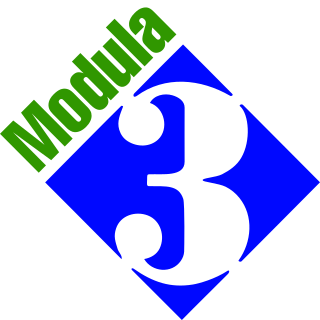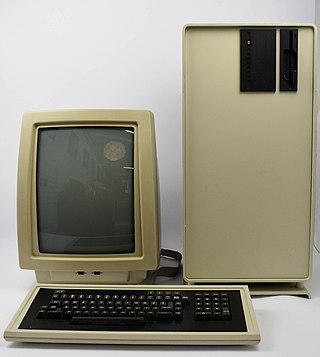The Modula programming language is a descendant of the Pascal language. It was developed in Switzerland, at ETH Zurich, in the mid-1970s by Niklaus Wirth, the same person who designed Pascal. The main innovation of Modula over Pascal is a module system, used for grouping sets of related declarations into program units; hence the name Modula. The language is defined in a report by Wirth called Modula. A language for modular multiprogramming published 1976.

Niklaus Emil Wirth was a Swiss computer scientist. He designed several programming languages, including Pascal, and pioneered several classic topics in software engineering. In 1984, he won the Turing Award, generally recognized as the highest distinction in computer science, "for developing a sequence of innovative computer languages".
Pascal is an imperative and procedural programming language, designed by Niklaus Wirth as a small, efficient language intended to encourage good programming practices using structured programming and data structuring. It is named after French mathematician, philosopher and physicist Blaise Pascal.
An object-oriented operating system is an operating system that is designed, structured, and operated using object-oriented programming principles.

Modula-3 is a programming language conceived as a successor to an upgraded version of Modula-2 known as Modula-2+. While it has been influential in research circles it has not been adopted widely in industry. It was designed by Luca Cardelli, James Donahue, Lucille Glassman, Mick Jordan, Bill Kalsow and Greg Nelson at the Digital Equipment Corporation (DEC) Systems Research Center (SRC) and the Olivetti Research Center (ORC) in the late 1980s.

The Oberon System is a modular, single-user, single-process, multitasking operating system written in the programming language Oberon. It was originally developed in the late 1980s at ETH Zurich. The Oberon System has an unconventional visual text user interface (TUI) instead of a conventional command-line interface (CLI) or graphical user interface (GUI). This TUI was very innovative in its time and influenced the design of the Acme text editor for the Plan 9 from Bell Labs operating system.
Component Pascal is a programming language in the tradition of Niklaus Wirth's Pascal, Modula-2, Oberon and Oberon-2. It bears the name of the language Pascal and preserves its heritage, but is incompatible with Pascal. Instead, it is a minor variant and refinement of Oberon-2 with a more expressive type system and built-in string support. Component Pascal was originally named Oberon/L, and was designed and supported by a small ETH Zürich spin-off company named Oberon microsystems. They developed an integrated development environment (IDE) named BlackBox Component Builder. Since 2014, development and support has been taken over by a small group of volunteers. The first version of the IDE was released in 1994, as Oberon/F. At the time, it presented a novel approach to graphical user interface (GUI) construction based on editable forms, where fields and command buttons are linked to exported variables and executable procedures. This approach bears some similarity to the code-behind way used in Microsoft's .NET 3.0 to access code in Extensible Application Markup Language (XAML), which was released in 2008.

The DISER Lilith is a custom built workstation computer based on the Advanced Micro Devices (AMD) 2901 bit slicing processor, created by a group led by Niklaus Wirth at ETH Zurich. The project began in 1977, and by 1984 several hundred workstations were in use. It has a high resolution full page portrait oriented cathode ray tube display, a mouse, a laser printer interface, and a computer networking interface. Its software is written fully in Modula-2 and includes a relational database program named Lidas.

Oberon-2 is an extension of the original Oberon programming language that adds limited reflection and object-oriented programming facilities, open arrays as pointer base types, read-only field export, and reintroduces the FOR loop from Modula-2.
PL/0 is a programming language, intended as an educational programming language, that is similar to but much simpler than Pascal, a general-purpose programming language. It serves as an example of how to construct a compiler. It was originally introduced in the book, Algorithms + Data Structures = Programs, by Niklaus Wirth in 1976. It features quite limited language constructs: there are no real numbers, very few basic arithmetic operations and no control-flow constructs other than "if" and "while" blocks. While these limitations make writing real applications in this language impractical, it helps the compiler remain compact and simple.
Modular programming is a software design technique that emphasizes separating the functionality of a program into independent, interchangeable modules, such that each contains everything necessary to execute only one aspect of the desired functionality.
Kronos is a series of 32-bit processor equipped printed circuit board systems, and the workstations based thereon, of a proprietary hardware architecture developed in the mid-1980s in Akademgorodok, a research city in Siberia, by the Academy of Sciences of the Soviet Union, Siberian branch, Novosibirsk Computing Center, Modular Asynchronous Developable Systems (MARS) project, Kronos Research Group (KRG).
A2 is a modular, object-oriented operating system with unconventional features including automatic garbage-collected memory management, and a zooming user interface. It was developed originally at ETH Zurich in 2002. It is free and open-source software under a BSD-like license.
IP Pascal is an implementation of the Pascal programming language using the IP portability platform, a multiple machine, operating system and language implementation system. It implements the language "Pascaline", and has passed the Pascal Validation Suite.

BlackBox Component Builder is an integrated development environment (IDE) optimized for component-based software development developed by a small spin-off company, Oberon microsystems AG, of ETH Zurich in Switzerland. The IDE consists of development tools, a library of reusable components, a framework that simplifies developing robust custom components and applications, and a run-time environment for components.

Active Oberon is a general purpose programming language developed during 1996-1998 by the group around Niklaus Wirth and Jürg Gutknecht at the Swiss Federal Institute of Technology in Zürich. It is an extension of the programming language Oberon. The extensions aim at implementing active objects as expressions for parallelism. Compared to its predecessors, Oberon and Oberon-2, Active Oberon adds objects, system-guarded assertions, preemptive priority scheduling and a changed syntax for methods. Objects may be active, which means that they may be threads or processes. As it is tradition in the Oberon world, the Active Oberon language compiler is implemented in Active Oberon. The operating system named Active Object System (AOS) in 2002, then due to trademark issues, renamed Bluebottle in 2005, and then renamed A2 in 2008, especially the kernel, synchronizes and coordinates different active objects.
The Ceres Workstation was a workstation computer built by Niklaus Wirth's group at ETH Zurich in 1987. The central processing unit (CPU) is a National Semiconductor NS32000, and the operating system, named Oberon System is written fully in the object-oriented programming language Oberon. It is an early example of an operating system using basic object-oriented principles and garbage collection on the system level and a document centered approach for the user interface (UI), as envisaged later with OpenDoc. Ceres was a follow-up project to the Lilith workstation, based on AMD bit slicing technology and the programming language Modula-2.
Modula-2 is a structured, procedural programming language developed between 1977 and 1985/8 by Niklaus Wirth at ETH Zurich. It was created as the language for the operating system and application software of the Lilith personal workstation. It was later used for programming outside the context of the Lilith.
Jürg Gutknecht is a Swiss computer scientist. He developed, with Niklaus Wirth, the programming language Oberon and the corresponding operating system Oberon.
Zonnon is a general purpose programming language in the line or family of the preceding languages Pascal, Modula, and Oberon. Jürg Gutknecht is the author.






